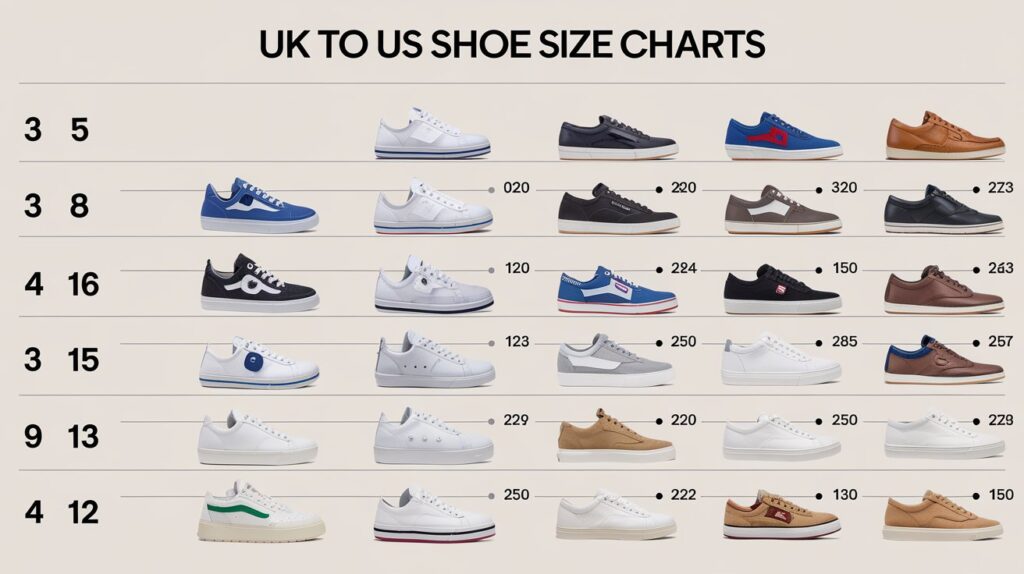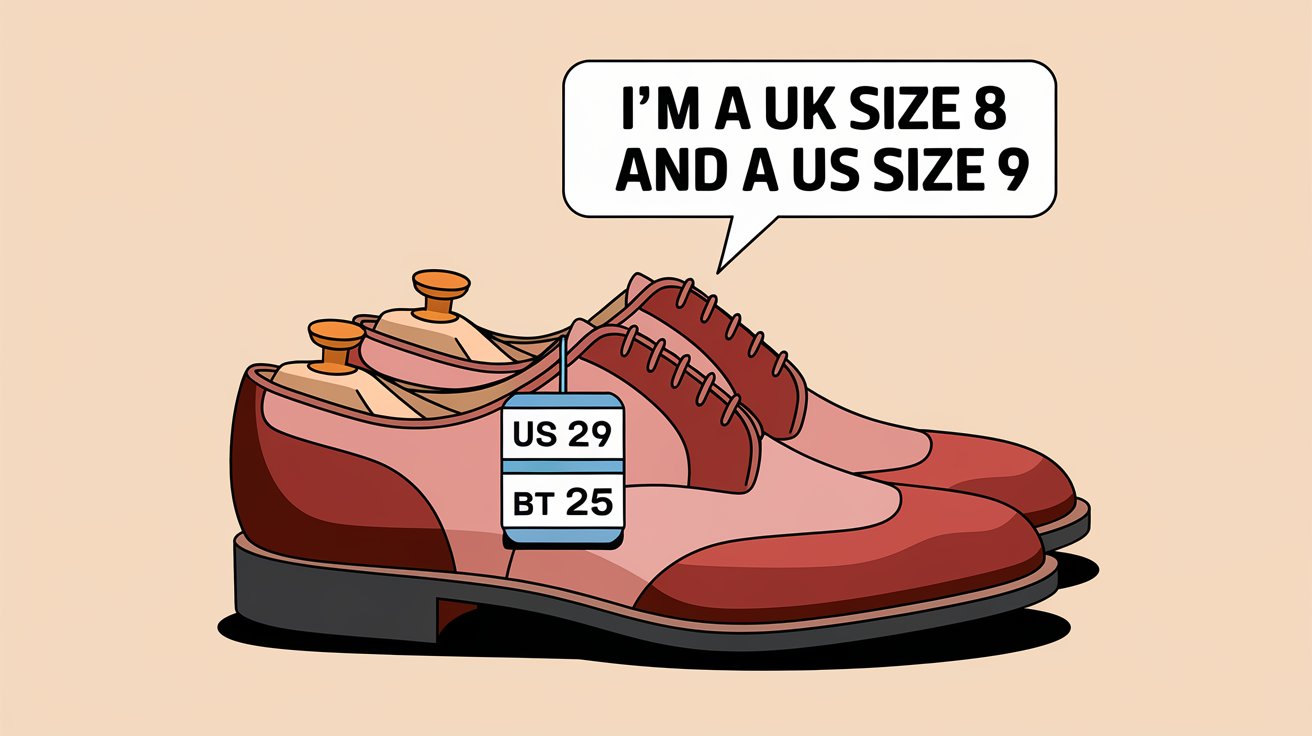Navigating the maze of international shoe sizes can be challenging, especially when transitioning between UK and US sizing systems. Whether you’re shopping online, traveling, or simply upgrading your footwear collection, understanding how to accurately convert UK shoe sizes to US sizes is essential for ensuring comfort and a perfect fit. This guide provides comprehensive conversion charts for men, women, and children, along with practical tips and insights to help you make informed decisions.
UK vs. US Shoe Sizing
Shoe sizing systems vary globally, making it essential to understand the differences to ensure a proper fit. The UK and US shoe sizing systems are two of the most commonly used, yet they don’t align perfectly.
- UK Shoe Sizes: Typically, UK sizes are one size smaller than their US counterparts for women and approximately the same for men. UK sizes often include half sizes, allowing for a more precise fit.
- US Shoe Sizes: US sizes tend to run slightly larger compared to UK sizes, especially for women. The system also includes half sizes, enhancing fit accuracy.
Key Insight: A UK size 8 is generally equivalent to a US size 9 for women and remains consistent for men. However, always refer to specific conversion charts and measure your feet accurately to find the best fit.
Why Accurate Size Conversion Matters
Choosing the wrong shoe size can lead to discomfort, foot pain, and even long-term health issues. Here’s why getting the size right is crucial:

- Comfort: Properly fitted shoes prevent blisters, calluses, and other foot irritations.
- Foot Health: Correct sizes support foot arches and prevent issues like bunions and plantar fasciitis.
- Performance: Athletes and active individuals benefit from shoes that fit well, enhancing performance and reducing injury risk.
- Longevity of Shoes: Proper sizing ensures that shoes wear evenly and last longer, saving you money in the long run.
Expert Tip: Always prioritize accurate measurements and conversion charts over size numbers alone to achieve the best fit.
Men’s Shoe Size Conversion
Understanding how men’s shoe sizes convert between UK and US systems is straightforward with the right chart. Below is a detailed conversion table to help you find the perfect fit.
Men’s UK to US Shoe Size Chart
| 🇺🇸 US Size | 🇬🇧 UK Size | Length (inches) | Length (cm) |
|---|---|---|---|
| 4 | 3.5 | 8.7 in | 22 cm |
| 4.5 | 4 | 8.8 in | 22.5 cm |
| 5 | 4.5 | 9 in | 23 cm |
| 5.5 | 5 | 9.3 in | 23.5 cm |
| 6 | 5.5 | 9.4 in | 24 cm |
| 6.5 | 6 | 9.6 in | 24.5 cm |
| 7 | 6.5 | 9.8 in | 25 cm |
| 7.5 | 7 | 10.3 in | 25.5 cm |
| 8 | 7.5 | 10.2 in | 26 cm |
| 8.5 | 8 | 10.4 in | 26.5 cm |
| 9 | 8.5 | 10.6 in | 27 cm |
| 9.5 | 9 | 10.8 in | 27.5 cm |
| 10 | 9.5 | 11 in | 28 cm |
| 10.5 | 10 | 11.2 in | 28.5 cm |
| 11 | 10.5 | 11.4 in | 29 cm |
| 11.5 | 11 | 11.6 in | 29.5 cm |
| 12 | 11.5 | 11.8 in | 30 cm |
| 12.5 | 12 | 12 in | 30.5 cm |
| 13 | 12.5 | 12.2 in | 31 cm |
| 13.5 | 13 | 12.4 in | 31.5 cm |
| 14 | 13.5 | 12.6 in | 32 cm |
These are guidelines. Please consult your shoe’s brand website for detailed sizing.
Converting Men’s Shoe Sizes – Tips and Calculations
Fun Fact: There is no hard-and-fast rule to sizing shoes. While there are guidelines and standard practices in the shoe-fitting industry, each brand (and region!) has different ways of converting shoe sizes.
Best Practice: Utilize your existing shoes as a reference. Compare a few pairs from different brands to average out a good fit.
Conversion Rules:
- To calculate UK size men’s shoes, subtract 0.5 from the US size.
- To get to the EU size, add around 33.
- To convert US to Japan men’s sizes, add 18.
Example:
A US size 10 is a 9.5 UK size. Converting to EU size would be 42.5, and Japan size would be 28.
Women’s Shoe Size Conversion
Converting women’s shoe sizes between UK and US systems is also straightforward with the right reference. Below is a detailed conversion table to help you find your ideal fit.
Women’s UK to US Shoe Size Chart
| 🇺🇸 US Size | 🇬🇧 UK Size | Length (inches) | Length (cm) |
|---|---|---|---|
| 4 | 2 | 8.1 in | 20.5 cm |
| 4.5 | 2.5 | 8.3 in | 21 cm |
| 5 | 3 | 8.5 in | 21.5 cm |
| 5.5 | 3.5 | 8.7 in | 22 cm |
| 6 | 4 | 8.9 in | 22.5 cm |
| 6.5 | 4.5 | 9.1 in | 23 cm |
| 7 | 5 | 9.3 in | 23.5 cm |
| 7.5 | 5.5 | 9.4 in | 24 cm |
| 8 | 6 | 9.6 in | 24.5 cm |
| 8.5 | 6.5 | 9.8 in | 25 cm |
| 9 | 7 | 10 in | 25.5 cm |
| 9.5 | 7.5 | 10.2 in | 26 cm |
| 10 | 8 | 10.4 in | 26.5 cm |
| 10.5 | 8.5 | 10.6 in | 27 cm |
| 11 | 9 | 10.8 in | 27.5 cm |
| 11.5 | 9.5 | 11 in | 28 cm |
| 12 | 10 | 11.2 in | 28.5 cm |
These are guidelines. Please consult your shoe’s brand website for detailed sizing.
Converting Women’s Shoe Sizes – Tips and Calculations
Fun Fact: Converting women’s shoe sizes is relatively straightforward, but variations still exist across brands.
Best Practice: Pull out a pair of your well-fitting shoes and compare them to the conversion charts to find an average size that works for you.
Conversion Rules:
- To calculate UK size women’s shoes, subtract 2 from the US size.
- To get to the EU size, add around 31.
- To convert US to Japan women’s sizes, add 16.5.
Example:
A US size 8 is a 6 UK size. Converting to EU size would be 38.5, and Japan size would be 24.5.
Kids’ Shoe Size Conversion
Children’s feet grow rapidly, making accurate sizing even more critical. Below are detailed conversion charts for infants, toddlers, and big kids to help parents ensure their children wear comfortable and supportive shoes.
Baby Shoe Size Chart
| Age | Foot Length (mm) | US Size |
|---|---|---|
| 0-3 months | 84-90 mm | 0.5C |
| 3-6 months | 91-98 mm | 1C |
| 6-9 months | 99-104 mm | 1.5C |
| 9-12 months | 105-110 mm | 3C |
| 12-18 months | 111-117 mm | 4C |
| 18-24 months | 118-125 mm | 4.5C |
| 2-2.5 years | 126-133 mm | 5.5C |
Toddler Shoe Size/Kid Shoe Size Chart
| Length (inches) | Length (cm) | US & Canada | UK | EU |
|---|---|---|---|---|
| 4.3 in | 10.8 cm | 3.5C | 2.5C | 19 |
| 4.5 in | 11.4 cm | 4C | 3C | 19 |
| 4.6 in | 11.7 cm | 4.5C | 3.5C | 20 |
| 4.8 in | 12.1 cm | 5C | 4C | 20 |
| 5 in | 12.7 cm | 5.5C | 4.5C | 21 |
| 5.1 in | 13 cm | 6C | 5C | 22 |
| 5.3 in | 13.3 cm | 6.5C | 5.5C | 22 |
| 5.5 in | 14 cm | 7C | 6C | 23 |
| 5.6 in | 14.3 cm | 7.5C | 6.5C | 23 |
| 5.8 in | 14.6 cm | 8C | 7C | 24 |
| 6 in | 15.2 cm | 8.5C | 7.5C | 25 |
| 6.1 in | 15.5 cm | 9C | 8C | 25 |
| 6.3 in | 15.9 cm | 9.5C | 8.5C | 26 |
| 6.5 in | 16.5 cm | 10C | 9C | 27 |
These are guidelines. Please consult your shoe’s brand website for detailed sizing.
Pro Tips for Choosing the Right Size
Achieving the perfect shoe fit goes beyond simply matching sizes on a chart. Here are some expert tips to help you make the best choice:
1. Measure Feet Later in the Day
Feet tend to swell throughout the day. Measuring in the afternoon or evening can provide a more accurate size.
2. Consider Sock Thickness
If you plan to wear thick socks or hosiery with your shoes, measure and try on shoes with the same type of socks.
3. Check Width Options
Some brands offer multiple width options (e.g., Narrow, Regular, Wide). Choose based on your foot’s shape to ensure comfort.
4. Walk Around in New Shoes
After trying on shoes, walk around to check for any discomfort, slipping, or tightness in specific areas like the toes or heels.
5. Consult Brand-Specific Size Guides
Different brands may have slight variations in sizing. Always refer to the specific brand’s size guide for the most accurate conversion.
6. Read Customer Reviews
Customer feedback can provide insights into whether a particular brand runs large or small, helping you make a more informed decision.
7. Utilize Existing Shoes as a Reference
There is no hard-and-fast rule to sizing shoes. While guidelines and standard practices exist in the shoe-fitting industry, each brand (and region!) has different ways of converting shoe sizes. Use your existing shoes as a benchmark to average out a good fit.
Example Conversion Rule:
- To calculate UK size men’s shoes, subtract 0.5 from the US size.
- To get to the EU size, add around 33.
- To convert US to Japan men’s sizes, add 18.
Example:
A US size 10 is a 9.5 UK size, converts to EU size 42.5, and Japan size 28.
Common Mistakes to Avoid
Avoiding these common pitfalls can save you time, money, and discomfort:
1. Relying Solely on Size Numbers
Foot shape and width play significant roles in fit. Don’t base your decision only on the size number; consider the overall fit and comfort.
2. Ignoring Brand Variations
Each brand may have its own sizing nuances. Always check the brand’s specific size chart rather than relying solely on general conversion tables.
3. Not Measuring Both Feet
One foot is often larger than the other. Always measure both feet and use the larger measurement to determine your shoe size.
4. Forgetting About Shoe Purpose
Different types of shoes (e.g., running shoes vs. formal shoes) may require different fits. Ensure the size is appropriate for the shoe’s intended use.
5. Buying Too Big or Too Small
While a little extra room can be comfortable, overly large shoes can lead to tripping or foot strain. Similarly, shoes that are too small can cause discomfort and injuries.
6. Forgetting to Check Return Policies
When buying online, ensure the retailer has a flexible return or exchange policy in case the shoes don’t fit as expected.
Final Thoughts
Converting UK to US shoe sizes doesn’t have to be a complicated process. By understanding the differences between the sizing systems, accurately measuring your feet, and utilizing detailed conversion charts, you can confidently select the right size every time. Remember to consider factors like foot width, sock thickness, and brand-specific sizing variations to ensure maximum comfort and fit.



Leave a Reply